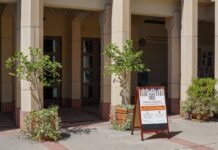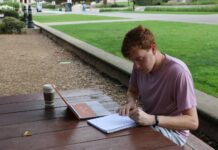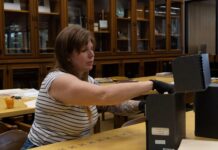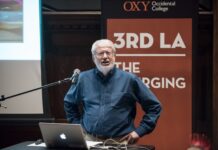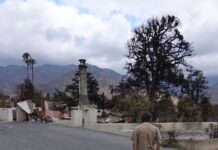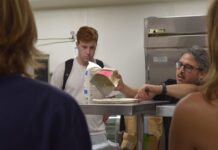Author: Richie DeMaria
At 5 a.m. every morning in the northeast Thai village of Nong John, the sounds of rustic life shook Katja Nelson and Annika Bushman (seniors) awake – not an alarm clock or traffic, but the laughter of schoolchildren and the clatter of pans, the rush of running water and the groans of a birthing cow.
It was the kind of wake-up call rarely heard in America, and a chorus that urban development threatens to silence in Thailand. During their stay the two Occidental students experienced a lifestyle that still persists, if only for a short time longer, in the practices and conservation efforts of the villagers.
Nelson and Bushman decided to help preserve the village life they experienced in a photo series. Entitled “Isan Living” after the northeast Isan region of Thailand, their exhibit, currently housed in the Weingart gallery, freezes this possibly endangered life in images.
“Isan Living” provides a close look into the life of Thai villagers. A mix of photography, collage and printmaking, the method of living on display is an agricultural way of life far removed from the urban L.A. lifestyle. One photo shows a man washing laundry in a lake; another, an elderly woman tilling the earth with her fingers; another, a woman, waist-high in water, plucking the day’s meal from the water below.
Nelson and Bushman’s photo exhibition is the unexpected outcome of their winter break trip. The two studied the Thai people for two weeks on a Values and Vocations grant.
Nelson, who studied abroad in Thailand in the spring of her junior year, returned to study the actions of the Conservation Club – a resistance organization focused on blocking potash mining in the Udon Thani province and funded by its members’ own rice farm – as well as to resolve questions she had about the country from her first visit, she said.
Bushman, who had never been to Thailand, said she went to research the relationship between communal living and well-being, to compare the values of a Thai village with the values of the West.
There, the two found much to love in the northeast regional way of life, but also witnessed the difficulties of living rurally in an increasingly urban Thailand. The trip ultimately left them with more questions than answers, Nelson said.
“I think a big reason for me to go back was to get some clarity on sustainability and development but I think I ended up more confused,” Nelson said.
The exhibition illustrates the tension between northeast Thailand’s agricultural lifestyle and increasing urbanization, a tension Nelson and Bushman saw firsthand in their first destination, the Udon Thani province.
It is in Udon Thani where the Conservation Club and village residents are embroiled in a dispute over land use with a major Thai development company, Italian-Thai. The residents of the Udon Thani province live upon one of the world’s richest deposits of potash, a valuable potassium salt used in fertilizers – a supply that has attracted the attention of Italian-Thai.
The thrust of the resistance comes from the Conservation Club, formed in 2002 by a cadre of elderly women who have come to be known as the Iron Ladies. Through their protests, the Club and supporting NGOs educated the villagers enough to thwart the construction of the potash mine.
As a result of the Conservation Club’s efforts, the villagers regard Italian-Thai’s proposed project with suspicion. Thai law requires villager consensus before such a project is undertaken, and few if any in the village have agreed to the proposed development. At present, the Iron Ladies refuse to engage in talks with Italian-Thai.
Any monetary compensation would be useless given their lifestyle. “I think their situation would be a lot worse if there were a development project in the community,” Nelson said. “They live off this forest, off this land, they’re really conservative with what they take – they really care about the environment.”
Were a potash mine built, the rural lifestyle of Udon Thani villagers would no doubt change. Yet the issue is not a matter of a noble, rural good against a large, corporate evil; a potash mine would profit the country as a whole. Most importantly, the potash mine would ensure self-sufficiency. Currently, the agriculture-based country currently imports much of its fertilizer from outside sources.
“I do understand . . . why the people in Italian-Thai feel so strongly about building the mines,” Nelson said. “They are not evil people, they just have a very different philosophy of development than the people in the Conservation Club.”
Next, the two traveled to Nong John – a village deemed an illegal violation of zoning laws when the Thai government made the surrounding land a national park. After that they traveled to the village of Chaing Kahn. In these villages the two partook in all the same activities – plowing in the fields, gathering and cooking food, herding cattle.
The dwellings were sparse by American standards, but, Bushman said, she and Nelson soon grew comfortable. These living spaces, with their backyard gardens and prayer spaces and lack of running water, made for compelling material. “I wanted to document these living spaces [through photography],” Bushman said.
At the show’s March 4 opening, gallery goers voiced mixed reactions over the agriculture-centered lives on display. Some saw in the photos a life worth envying, an intimate relationship with the land preferable to our more industrialized standards; others quietly pitied what they saw as an impoverished existence, a lacking country life.
“It is difficult to say what is better; our consumer capitalist way of life versus their more simple and natural way of life,” Nelson said. “It is obvious to me, however, that the people in the villages live far more harmoniously with the land than we do. As we deplete our resources, they think about living sustainably.”
Bushman, who studied the well-being of communal villages, found the residents of Nong John and Chaing Kahn had a greater understanding of their resources – and in turn, themselves.
“Our way of life comes prepackaged in many ways so that there is a greater disconnect between us and our food, environment, relationship to each other and any sense of community,” she said. “No one mentioned material goods or finances when responding to my questions [about what made them happy.]” Several of the photos document this living-off-the-land, with villagers sourcing their own food from the surrounding area, filleting fish, picking fruit.
The life of the Thai people the two met, however, was not ideal, either, evidenced in the high rate of heavy drinking and poor health coverage that they witnessed.
“I had these ideas of life in a small community like a co-op, this straightforward definition that’s very purposeful and planned out,” Bushman said. “After being there, you see okay, these people are living okay but there are a lot of elements that were sort of sad to see. The alcoholism, education, basic health services.”
Nelson and Bushman also offered the villages a glance at photography, a medium they rarely come across. Nelson showed the residents a single photo from her previous Thailand trip, and the villagers, Bushman said, “went crazy for it.”
Their photography even connected one Nong John villager with her daughter, who lived on the opposite side of the world, in Los Angeles. Her daughter moved to California with her husband, and now lives here with three children. Nelson and Bushman happened upon this woman, who told them of her American daughter. After several tries, they contacted the villager’s daughter with photos of the village of her birth.
“It must be really unusual for this girl who grew up in this really tiny village for someone to find her and say, here are a ton of photos of your mother,” Nelson said.
In learning about and documenting a culture other than their own, Nelson and Bushman managed, through sheer coincidence, to bridge two cultures together.
“In a rou
ndabout way we made the world much smaller,” Bushman said.
Ideally, their exhibit may do the same for its viewers, provoking not sympathy but an admiration, or at least an awareness, of the Thai tenacity, of their resilience in the face of possible change. However, depicting and aestheticizing a life entirely unlike our own, “Isan Living” may run the risk of provoking detachment, of rendering quaint their rural life. This, Nelson says, is not the goal.
“They love their lives and they live sustainably off the land,” she said. “Why do we sympathize for these people that are so happy and have found the balance of living sustainably off the land?”
“Isan Living” will remain in Weingart until March 31.
This article has been archived, for more requests please contact us via the support system.
![]()


